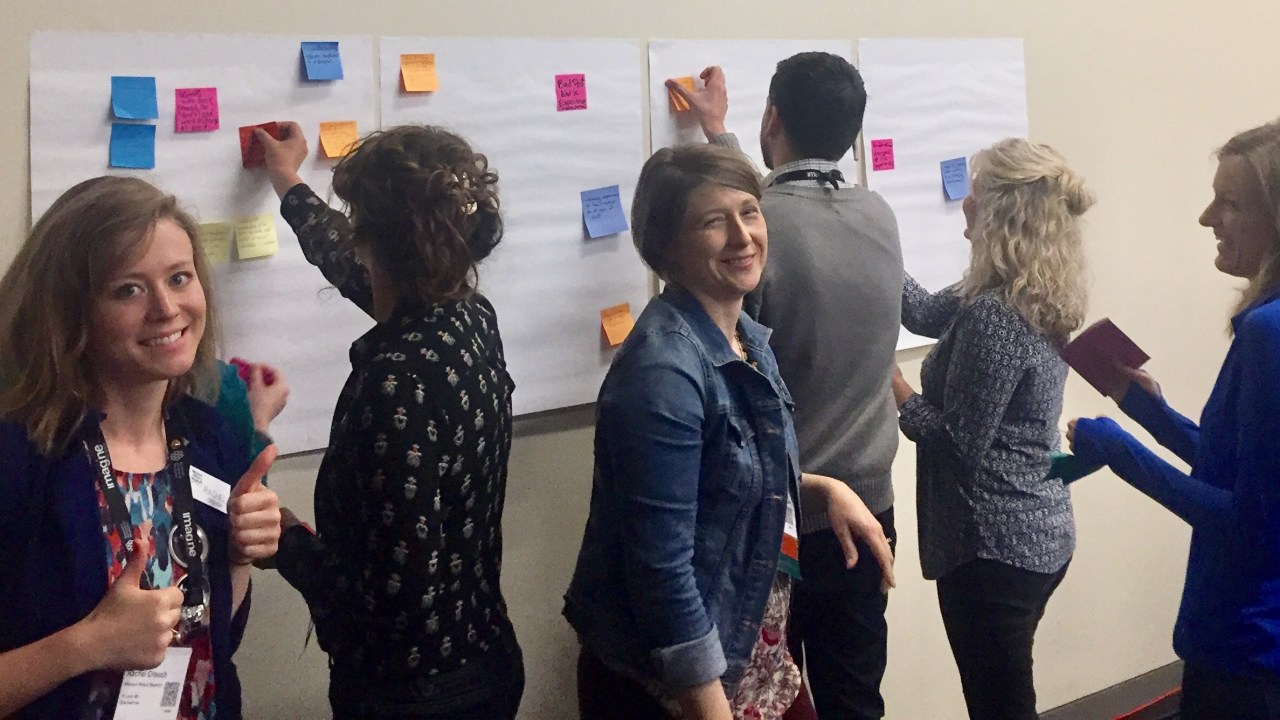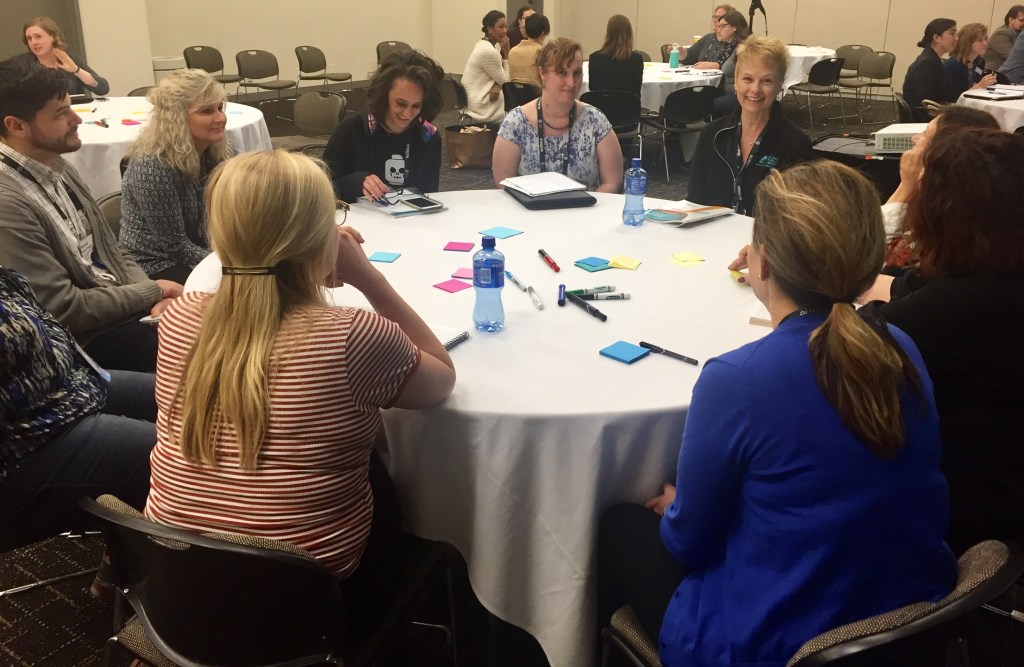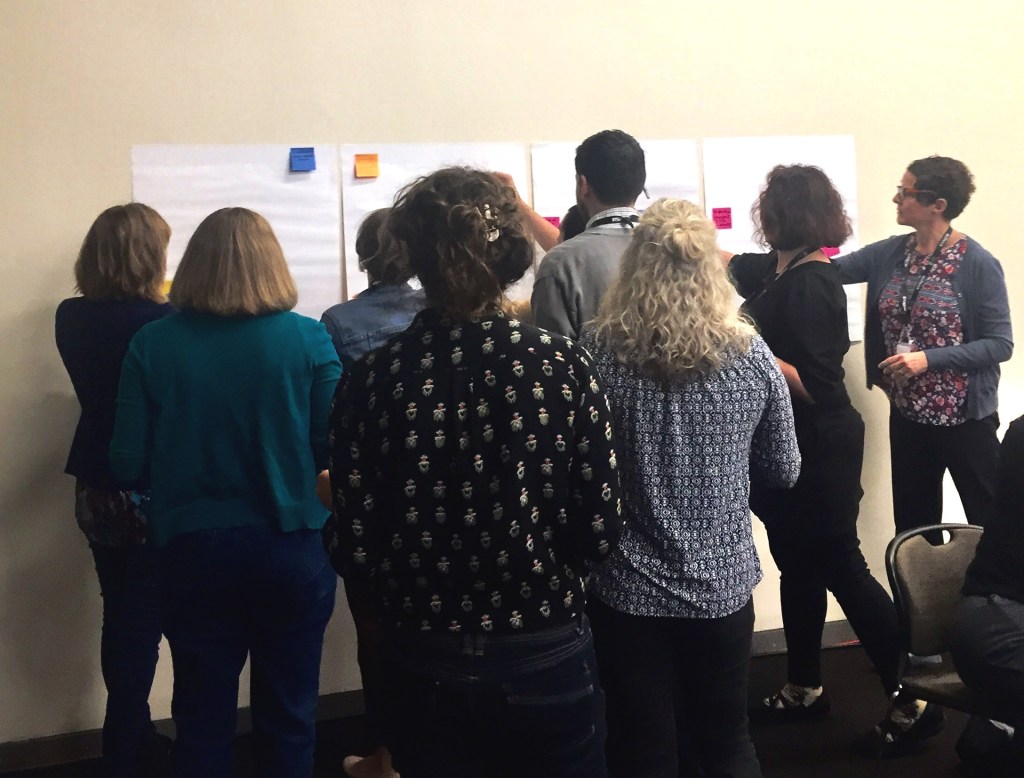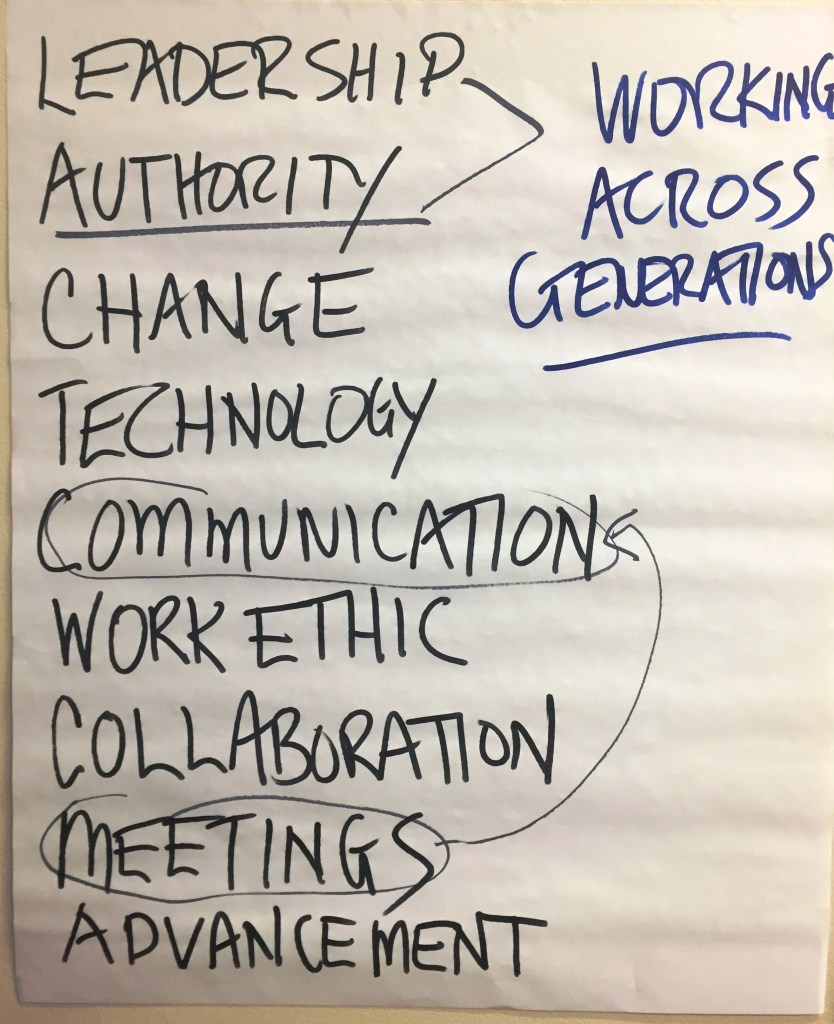
This article originally appeared in Informal Learning Review (ILR) No. 144, May/June 2017. A copyrighted publication of Informal Learning Experiences, Inc. Reprinted with permission.
My recognition of the power and importance of intergenerational collaboration began with my involvement with Generations United, a Washington-based organization,1 while serving as the Director of Strategic Partnerships at the Institute of Museum and Library Services. Generations United (GU) was founded more than thirty years ago by representatives from organizations from the Children’s Defense Fund to the AARP (formerly the American Association for Retired Persons), and has, as its mission, “to improve the lives of children youth and older people through intergenerational collaboration, public policies, and programs for the enduring benefit of all.” A winner of the 2015 Eisner Prize for Lifetime Achievement in Intergenerational Advocacy, GU has created toolkits for building effective intergenerational communities, fostered effective intergenerational practices in the workplace, including libraries and museums.
In the spring of 2016, I met Elizabeth Isele, founder and CEO, GIEE (Global Institute for Experienced Entrepreneurship), SavvySeniorsWork, and CyberSeniors.org. Isele hosts cross-sector, cross-generational forums worldwide to engage community support in solving some of today’s most challenging social and economic problems, and positively transform lives of individuals of all ages.2 One of her powerful examples was the 2012 film, The Best Exotic Marigold Hotel. In the film, a young and eager Indian entrepreneur, played by Dev Patel, who is long on vision, drive, energy, and chutzpah but short on experience, taps the entrepreneurial wisdom of senior British expatriate Maggie Smith (savvy about numbers and household management who had been outsourced from her UK position) to make his dream a reality. This film, and its 2015 sequel, The Second Best Marigold Hotel, serve as humorous and poignant examples of the power of intergenerational collaboration.
Generational Issues in Museums
Accordingly, the 2017 American Alliance of Museums (AAM) Annual Meeting theme, “Gateways for Understanding: Diversity, Equity, Accessibility, and Inclusion in Museums,” prompted my suggesting two sessions, one organized by The Museum Group (TMG) and the other in concert with AAM’s Career Track, which would explore the theme through the lens of age. How do ageism and other generational stereotypes and assumptions limit our potential and impact? These sessions illuminated prevailing age-related issues and provided multi-generational forums for exploring strategies that push through our stereotypes and negative experiences in order to create a more productive multi-generational workplace and more fulfilled museum professionals and volunteers.
One session, “Generational Inclusion: Shattering our Stereotypes, Challenging Our Assumptions,” was a conversation sponsored by TMG featuring septuagenarian Elizabeth Isele and Millennial Samuel Moore, with my facilitation. Samuel Moore is Online Communications Coordinator at the Missouri History Museum, managing social media, email marketing, web content, and online initiatives for the Museum, its Library and Research Center, and Soldiers Memorial Military Museum.3
The other session, “Working Across Generations (or Intergenerationality),” was co-facilitated by Greg Stevens, the Director of Professional Development at AAM, and me. Greg has spent the last decade planning, implementing, and evaluating a wide range of professional development programs, including those focusing on leadership, career development, diversity, and workplace issues. Each of the two sessions attracted a multi-generation audience, with the “Generational Inclusion” session tilting toward Baby Boomers and beyond, and the “Across Generations” session attracting a majority of Gen-X’ers and Millennials.
We began each session with the observation that, for the first time in history, many organizations, including museums are dealing with a five-generation workplace. If your organization includes seasoned staff or volunteers born in 1945 or earlier with longstanding museum affiliation or pursuing “encore” work (“Traditionalists”); GenX’ers (born 1965-1976); Millennials (born 1977-1997) as well as youthful staff or volunteers (teen docents, explainers, youth council directors) born in 1997 or later (Gen Z or Gen2020), you are likely to be in this situation.

Popular media, and, to some extent, our individual and collective experiences, have perpetuated descriptors for each generation. Organizational development pundits, sociologists, human resource professionals, and others – fed by some of our own experiences – have helped to create and disseminate these generational categories and associated them with historical markers, social and cultural trends, and not-always-consistent workforce qualities and values.
It is important to note that, as with every diversity issue, although the five generations have different values, different ideas, different ways of getting things done, and different ways of communicating, there is little homogeneity within each group. Within any generation, for example, there will be individuals on the older end of the spectrum and those on the younger; this difference alone, coupled with socio-economic, geographic, demographic, psychographic or other factors, influences individuals and our perceptions of each other. Similarly, each generation has many outliers and often the members of a particular age cohort resent being put into a generational “box.” In the session conversations, as we collectively recognized generational differences, our participants suggested that there are many benefits that can accrue from breaking out of age-related silos, celebrating difference, and pursuing an “it-takes-a-village” multi-generational approach, accompanied by respect, empathy, and trust for individuals.

We based each session on the following tenets:
- A multi-generational approach adds value and is a rich asset to organizations. We framed our discussion with this statement from the Generations United/Met Life Mature Market Institute workbook, Generations in the Workplace: Engaging the Best Talent of All Ages, “Intergenerational can be thought of as inclusionary—creating a stronger, more cohesive environment through shared values and understanding among the generations. Intergenerational practices are important because they lead to optimum performance by leveraging the skills of each generation for organizational success.”
- The culture of an organization has a major impact on employee satisfaction and retention.
- Each generation brings strengths that can enrich the strengths of the organization.
- Each generation has valuable knowledge and skills that can — and should — be transferred to others.
- Generational stereotypes can adversely affect the organizational culture.
In both sessions, we invited participants to identify age-related issues and concerns as well as success stories. Concerns raised by participants included preferred communication methods (including the challenges of generation-specific “tribal” language); use (and mastery) of technology; work ethics and work styles; varying approaches to (or attitudes about) collaboration; privileging seniority over skills; reward systems, promotion and advancement; different approaches to change; different leadership styles; and, simply, sincere and authentic respect and recognition for individual skills and experience.

One Baby Boomer noted that when she tried to level the playing field and provide more agency and authority for younger staff at her museum, she met resistance. The organizational norms favored a “vertical,” more hierarchical approach, and colleagues were not inclined to challenge established policy or practice in order to develop productive multi-age strategies. Another participant, an older Gen X-er, suggested, with a slightly pejorative tone, that Millennials come to the workplace with a “sense of entitlement,” illustrating one of the real, fundamental challenges to working across generations: the importance of overcoming stereotypes and assumptions about specific groups of people.
Elizabeth Isele counseled an “ideas in motion” approach: Forget the generational charts and defining generational descriptors. Isele suggested that we pick a current workplace problem that relates to a specific intergenerational issue (like communication, promotion potential, technology norms, etc.); create a cross-generational group; charge the group to take an entrepreneurial, problem-solving approach; ask questions; build trust. Then, develop a wide range of ideas and iterate on those ideas. Focus on some small but actionable steps to make the preferred idea a reality. Try the idea out.
“Today’s Boomers are the largest, healthiest and best-educated generation the world has ever seen. They are eager to continue contributing well beyond the “retirement age.” More than simply academic, their knowledge is grounded in experience, creating powerful “Deep Smarts.” Catalyzing the varied degrees of experience across generations opens unprecedented opportunities to contextualize knowledge, implement it in practice, and amplify social and economic benefits for people of all ages.” – Elizabeth Isele
This process calls on such non-generation-specific skills as questioning, observation, analysis, critical thinking, self-discipline, managing risk, documentation, prototyping, and collaboration. Isele stressed the importance of curiosity and courage in making progress, also noting the importance of valuing reciprocity and equity. “We are in a brand new critical period,” noted Isele, “that is providing many unprecedented opportunities.” She shared that Japan’s Prime Minister Abe has coined a phrase, “Agenomics” to leverage the older workforce to benefit the country’s economic situation. Simply asking questions, offered Isele, can grow respect, open up communication paths, and lead to positive change and strong relationships.
Sam Moore commented that the Missouri History Museum addresses some of these potential conflicts using issue-focused task forces that assemble multi-generational groups to solve problems. He also noted this approach has likely contributed to many positive institutional outcomes, including record-breaking attendance and positive community engagement. Additionally, the simple act of bringing together staff from across the institution, young with old, leaders with lower-level employees, often brings people to the table who might not otherwise have ever sat across from each other in the same meetings. These seeds, thus planted, form the basis for what can become effective cross-generational partnerships within the institution. He advised junior museum staff to “go past the book,” such as museum studies texts. Instead, Moore offered, “Talk to people. Build relationships. Ask a senior colleague to lunch. Make an appointment. Don’t assume lack of interest. Take the first step.”
“Like any generation, there’s more than meets the eye when it comes to Millennials. Behind the incendiary headlines, the members of “Generation Y” are actively contributing to the modern workplace, they’re eager to make a difference and, more than anything, they’re eager to be fulcrums for change. While there’s no denying the Millennial generation has plenty to learn from generations previous, the value of the questions they bring to the table, namely “why not try it this way instead?” can’t be understated.” – Sam Moore
In each session, the need for and roles of mentors surfaced as key ingredients to a healthy workforce and a stronger museum. In the “Generational Inclusion” session, Moore noted, “I crave mentorship, from my first experiences in museums through today. It’s not as obvious to me that older generations are willing to mentor.” A Baby Boomer in this session reminded the other Boomers: “We were all cranky 24-year-olds, with drive and ambition. We need to support the younger generations and support them through mentoring. When I entered the museum world, my volunteer corps was more permeable and helped me more than my paid staff members. In my view, you are never too young to be a mentor, nor too old to be mentored.” In the “Working Across Generations” session, Greg Stevens reinforced the idea that mentoring can take many shapes—peer mentoring, situational mentoring, even reverse mentoring (where a younger or lower-level but more-skilled colleague mentors an older, perhaps less-skilled colleague in a particular task or circumstance).
A Traditionalist in the “Generational Inclusion” session noted, “We (in society) are having many ‘again’ moments; that is, we are confronting some issues, like civil rights, immigration policy, and demographic change, that we have addressed before. How can we seniors use our past experiences to inform and enrich younger staff’s perspectives with the ‘now’?” Similarly, in the “Working Across Generations” session, Stevens reminded us that the current discourse around diversity is not necessarily a new one in our field: “The conversations about diversity, accessibility, and equity were taking place 25 years ago, 40 years ago, and more. The generational conversation we are having now is as much a part of the broader diversity conversation as it has ever been. There have always been, and always will be, ‘kids these days’.” It’s time to take a more pro-active approach to this issue, concludes Stevens.
In both sessions, there were some great examples of knowledge transfer and the power of cross-generational collaboration. Moore shared that he did not know how to use the Missouri History Museum’s card catalog until he decided to ask the library staff some questions. Moore said, as a result, “Whole new worlds of information have opened up to me.” On that note, a participant in one session described a current project involving the Tom & Ethel Bradley Center at California State University, Northridge. The Multigenerational Archival Employment and Training Initiative “will provide paid employment training for high school students in digital archival basics, employ the skills of college students for metadata application and research, and compensate first voice senior citizens for photo image content, context authentication, and identification of persons and places in the photographic images.” In this pilot project, “Everyone gets paid. The students scan the documents. The seniors answer the ‘why.’” Stevens offered that even helping a colleague with “seemingly simple things like spreadsheets and PowerPoints can be catalysts for cross-generational learning and support.”

In the “Working Across Generations” session, participants identified specific issues they are confronting in their respective museums — change, technology, leadership and authority, communication/meetings, work ethic and work style, advancement and promotion — and then decamped into roundtable discussions where they could explore each issue, and perhaps arrive at a few tactical steps they might take back in their home institutions. Each table turned out to be multi-generational, and, although there wasn’t much time to map detailed action plans, each group came up with thoughtful reflections and useful “first steps” toward addressing cross-generational issues in their museums. Among the action steps identified were:
- Work to collaborate.
- Model respect for everybody.
- Learn to compromise.
- Build mutual understanding and trust.
- Create staff focus groups to learn more about staff views on different issues.
- For those resistant to social media, have a conversation in order to learn more about their reservations.
- Surface assumptions and expectations about workplace ethics and attitudes. Practice active listening and providing constructive feedback.
- Ensure that team members understand and articulate expectations, goals, and team dynamics around collaboration.
- Document and share project timelines, team roles, results, and products.
- Demonstrate empathy for people at different stages of their careers.
- Anchor meetings by reminding attendees how the meeting supports the museum’s mission.
- Try using various channels of communication with different colleagues, considering tone as well as content.
Conclusion
Although these conference-based discussions barely surfaced the manifestations of current generational challenges in museums and some strategies to overcome them, they nonetheless helped to probe, from multiple perspectives, an aspect of diversity and inclusion — within our organizations — that has received relatively short shrift in our sector. There exist minimal references to intergenerational museum programs and practices; however, there is even less literature on multi-generational issues within the museum workplace. With current demographic trends pointing toward continuing the five-generation workplace for the foreseeable future, and Gen Z (or Gen 2020) fully emerging in the workforce by 2020, this is an area that needs further exploration, including case studies of museums that are intentionally, and successfully, leveraging all of these generations for the benefit of the institution, the staff and volunteers, the community, and the museum field as a whole.
About the Authors
Marsha Semmel is President, Marsha Semmel Consulting. She may be reached at marsha.semmel@gmail.com. Elizabeth Isele is Founder and CEO, Global Institute for Experienced Entrepreneurship. She may be reached at elizabeth@experieneurship.com.
Samuel Moore is Online Communications Coordinator at the Missouri History Museum. He may be reached at smoore@mohistory.org.
Greg Stevens is Director, Professional Development, American Alliance of Museums. He may be reached at gstevens@aam-us.org.
End Notes
[1] http://www.gu.org
[2] www.experieneurship.com
[3] https://mohistory.org
Useful Resources
Diversified Services blog. February 19, 2016. “The 5 Generations in the Workforce.” Accessed April 27, 2017 from http://www.ddiversified.com/2016/02/19/the-5-generations-
in-the-workplace/.
Generations United. May 2017. I Need You, You Need Me: The Young, the Old, and What We Can Achieve Together. Report and Survey. Generations United, The Eisner Foun¬dation. Accessed June 13, 2017 from http://www.gu.org/RESOURCES/PublicationLibrary/INeedYouYouNeedMe. aspx.
Howe, Neil and William Strauss. July/August 2007. “The Next 20 Years: How Customer and Workforce Attitudes will Evolve.” Harvard Business Review.
Howe, Neil and William Strauss. The History of America’s Future, 1584-2069. Quill William Morris, New York.
Knight, Rebecca. September 25, 2014. “Managing People from 5 Generations.” Harvard Business Review. Accessed January 20, 2017 from https://hbr.org/2014/09/managing-
people-from-5-generations.
MetLife. 2009. Workbook. Generations in the Workplace: Engaging the Best Talent of All Ages. MetLife Mature Market Institute and Generations United.
Taylor, Sylvester and Bill Pasmore. January/February 2017. “Critical Competencies.” Workforce (workforce.com).
Trustees of Boston College. 2009. Engaging the 21st Century Multi-Generational Workforce: A Study for the MetLife Mature Market Institute by the Sloan Center on Aging &
Work at Boston College.
Zemke, Ron, Claire Raines and Bob Filipczak. 2000. Generations
at Work. AMACOM American Management Association.







